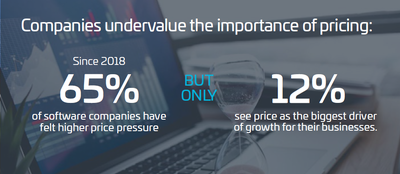The phenomenon of instant gratification and pay-as-you-go service has crossed over into the B2B world as well. What began with software-as-a-service over a decade ago is now transforming entire industries—from music, video, home automation, transportation, and medical devices to industrial automation.
We know that an estimated 50 percent of all industries are pricing and packaging their offerings as services with flexible subscription- or consumption-based pricing models.
And Forrester recently noted that the gap between B2B and B2C is also closing, and that B2B is also becoming more service-focused: "the experiences we have every day with brands like Apple and Amazon set the bar for what we expect more and more of our B2B purchases to be like".
Becoming more service-centric means not only having to package your products differently, but having to sell differently. According to McKinsey, "vendors must do more than offer a subscription-pricing model on a product hosted in the cloud. They need to match the streamlined, customer-friendly as-a-service product-delivery experience with a similarly streamlined and customer-friendly end-to-end journey".
Pricing & Packaging Considerations
As part of selling differently, your pricing structure needs to change. Companies transitioning from hardware to software and from on-premises to cloud, may find the way they used to charge for their products no longer works for their new business models or new go-to-market. Aside from a major deployment transition, companies also realize that recurring revenue models provide longer and more predictable revenue streams and make their products more affordable across a wider breadth of potential clients.
A recurring revenue model is not only about price levels; it is also about how price is communicated, what it means as a measure of value for a customer, and how products and services can be configured to best align with your company’s adoption and cross-sell strategies. Dealing with Pricing Pressures
Pricing is one of the most significant factors impacting your business, and it's easy to underestimate it. A recent pricing study by Simon Kucher and Partners found that "a 5% improvement in pricing without volume loss and average margins can boost profits easily by 30% to 50%".
Unfortunately, increasing prices can be more complicated than it sounds.
Companies trying to increase their prices last year reported they were only able to achieve 28 percent of the total price increase, which is the lowest price increase achievement ever recorded by this study.

These statistics reflect dire circumstances for many companies, and illustrate the challenges associated with raising prices. In response, companies are using varied options to properly price their products for the market.
Introducing new, innovative, or differentiated products is a powerful way to break out of a price erosion spiral. However, this is not always an option for all companies, and there are times when innovations are not a big enough change to alter the basis of competition.
Conversely, changing the revenue model and the way customers think about price and value can be a strategic option at any point in time. This is not to say that you should change your revenue model frequently to increase your pricing power year over year. Rather, you can change your pricing model at any time to help customers better understand the value you provide, make direct pricing comparisons more difficult, provide a means to differentiate yourselves from your competition, and align pricing more closely to customer value and willingness to pay.
The Implications of Changing Your Pricing
Many companies under price pressure want to change or are actively planning to change their price model. Given that reality, transitioning to a recurring revenue model will have broader implications on product structure, the way your organization interacts with your customers, and the way your customer interact with your product. Therefore, it is important to consider your revenue model transition carefully and make sure the components work together to meet your organization’s goals.
Using the right technology is core to optimizing innovative business models and recurring revenue streams. Rather than trying to cobble together a solution on your own, you can use existing commercial technology to your advantage.
In part one of our latest whitepaper Higher Revenue, Happier Customers, we help you focus on becoming customer-centric and integrating new technology-enabled pricing models to accomplish this goal.
Check out part 1 of our Higher Revenue, Happier Customers white paper: Create Recurring Revenue with Software Licensing.

 Zvi Rapps | Marketing Writer
Zvi Rapps | Marketing Writer